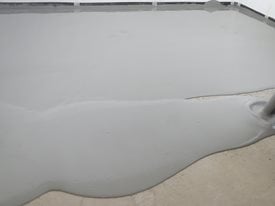
T.SALAMATIK / Shutterstock.
Whether you want a decorative concrete floor or plan on installing tile, wood, carpet, or another type of flooring, having a level concrete subfloor is important. Unlevel surfaces can create safety hazards, make furniture wobbly, and cause other issues. It can also be frustrating to have a floor with bumps, dips, or other imperfections. Read on to learn how to level a floor.
Find concrete floor contractors near me.
What Causes An Uneven Concrete Floor?
Several factors can cause an uneven concrete floor. When the concrete surface was poured, things like ambient temperature and even the humidity can affect the way it sets. The quality of the concrete mix can also affect the results. There may also be a more serious issue such as incorrectly placed floor joists.
How Do You Level an Uneven Floor?
If you’re interested in leveling your existing concrete surface, here’s a general outline for approaching the task:
- Clean the surface, removing ceramic tile or materials such as wood, paint, or other flooring from the concrete subfloor. You’ll also want to remove any grease and oil spots.
- Use an angle grinder or shot blaster on the concrete to completely clean the surface and create a smooth surface that your concrete leveling material will adhere to properly. This surface preparation step will create a lot of dust and debris, so be sure to wear proper face coverings.
- Sweep off any loose debris and look for any leftover glue, grout, or the like that needs to be ground off the surface.
- Look for high spots, dips, or sloping areas and use a level to find uneven spots that aren’t noticeable to the naked eye.
- Mark areas that need to be leveled.
- Use one of the following for leveling concrete floors (the one you should use depends on the severity of the uneven spots):
- Concrete floor patch: A good fix for minor issues such as small dips or thin sloping repairs with a small surface area (it’s also used for fixing minor cracks).
- Underlayment or self-leveling overlay: Best for larger areas, these acrylic-based products can be poured over a concrete slab. Unlike a regular concrete mix, a floor-leveling compound isn’t viscous, so it flows over a surface—filling in areas that slope or have dips.
Note: Depending on the product you use, you may need to use a self-leveling primer. Be sure to follow all package instructions.
- Allow to dry for the amount of time indicated on the concrete floor patch or concrete leveler compound package instructions, typically at least 24 hours.
Can You Pour Self-Leveling Concrete Over Existing Concrete?
Yes. You can pour self-leveling concrete over existing concrete, but before you do, you must prepare the surface properly by cleaning it thoroughly, so the concrete floor leveler compound adheres to your existing surface. See the section above, “How Do You Level an Uneven Concrete Floor?” for more information.